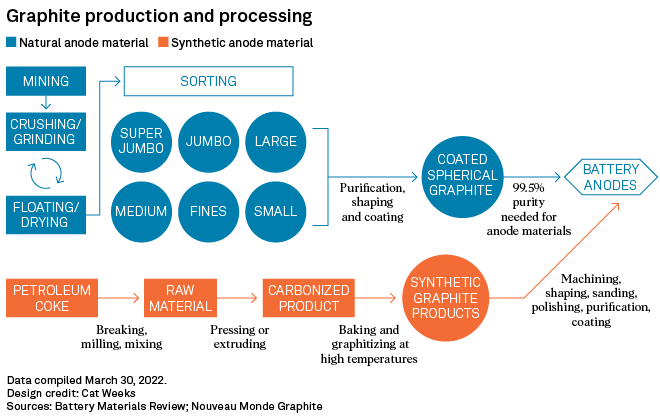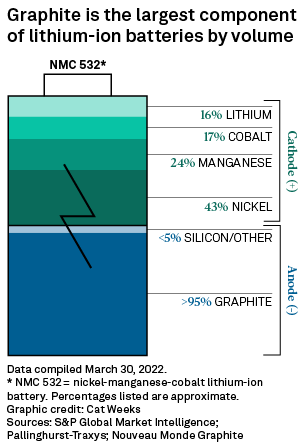S&P Global Offerings
Featured Topics
Featured Products
Events
S&P Global Offerings
Featured Topics
Featured Products
Events
S&P Global Offerings
Featured Topics
Featured Products
Events
Banking & Capital Markets
Economy & Finance
Energy Transition & Sustainability
Technology & Innovation
Podcasts & Newsletters
Banking & Capital Markets
Economy & Finance
Energy Transition & Sustainability
Technology & Innovation
Podcasts & Newsletters
S&P Global Offerings
Featured Topics
Featured Products
Events
7 Apr, 2022
By Camille Erickson

| Nouveau Monde Graphite's Matawinie mine under construction north of Montreal. The company plans to install an all-electric mining equipment and vehicle fleet by 2028 and rely on nearby hydroelectric power to offset carbon emissions associated with graphite production. |
Production of graphite, the largest component of electric vehicle batteries by volume, relies on petroleum coke and other fossil fuels, creating a dilemma for carmakers pushing EVs as a zero-carbon transportation solution.
An EV requires about 10 to 15 times more graphite in a battery than lithium. The graphite that will go into making the estimated 9.5 million EVs sold in 2022 could generate roughly 11.17 billion kilograms of CO2 equivalent during production,
Analysts agree that EVs remain a far less carbon-intensive mode of transport than vehicles with internal combustion engines. With sales of EVs mounting fast, demand for graphite is expected to climb from 140,000 tonnes in 2020 to over 3.5 Mt in 2040, according to the International Energy Agency.
The explosion in demand has shoved the oft-overlooked mineral into the spotlight as one of the more energy-intensive battery materials to produce, especially in its high-purity synthetic form. Downstream companies, under pressure from consumers to address climate impacts along EV supply chains, are starting to scour the globe for low-carbon sources of graphite to keep emissions at bay.
"The cost of synthetic graphite is really pretty high because of the energy consumption to make it," said John DeMaio, president of the graphene division of Hong Kong-headquartered Graphex Group Ltd. and CEO of its U.S. subsidiary, Graphex Technologies. "And, of course, it's a petroleum product. The reason we are doing electric vehicles is to move away from that."

The move to natural graphite
Synthetically made graphite is produced from oil byproducts, such as calcined petroleum coke and coal tar pitch. During the graphitization process, the feedstock is heated to at least 3,000 degrees Celsius in furnaces often powered by coal.
In contrast to synthetic graphite's chemical origins, natural graphite is mined from ore bodies and can be significantly less energy-intensive to produce, depending on the type of raw materials, technology and energy mix used. Making natural graphite for batteries can still come with environmental consequences, according to industry experts. Mined graphite is typically purified using hydrofluoric acid and sodium hydroxide, a process that can be dangerous to surrounding ecosystems if runoff and wastewater are not properly controlled. And calcined petroleum coke is used to upgrade the graphite.
"Graphite is a very energy-intensive production process, whether that's natural or synthetic," said Robert Pell, co-founder and CEO of Minviro, a U.K. consultancy firm that conducts life cycle assessments for graphite and other mineral companies. "That impact was quite significantly underestimated historically."
Graphite production is concentrated in China, which mines 69% of the world's graphite and produces 100% of spherical graphite, or battery-grade anode material, according to Benchmark Mineral Intelligence.
"There's a reason why the energy-intensive graphitization process sits there: The energy is cheap because it's coal-dominant," Pell said. "When you look at that in the context of where that material is going, for the low-carbon transition, there's obviously a contradiction there."
 |
Battery-grade synthetic graphite is made from oil feedstock. Producing 1 kilogram in China produces about 17 kilograms of CO2e, according to the latest data collected by Minviro. Making 1 kilogram of natural graphite in China — a mined form of the material — produces approximately 16.8 kilograms of CO2e.
Lithium, another major battery ingredient, produces about the same level of emissions when extracted from hard rock, but as little as 0.3 kilogram of CO2e per kilogram of lithium carbonate equivalent
Some companies have elected to add more natural graphite into battery anode chemistries, mixing the material with its synthetic cousin, to lower costs and emissions.
"The trend is actually towards more natural graphite," said DeMaio of Graphex, a natural graphite processing company with operations in China. "That is partly because of the cost."
Getting the carbon out
Though graphite is also used in industrial applications, over half of global demand is expected to come from the battery sector in 2022, the first time batteries used up the majority of the flakey mineral. The global graphite market is expected to face an 80,000-tonne to 90,000-tonne deficit as soon as 2022, according to Benchmark Mineral Intelligence. By 2030, 81% of graphite produced worldwide will go toward making batteries.
Only a handful of producers are prepared to fill the supply gap in battery-grade graphite, and an even smaller number of companies plan to use low-carbon processes.
A few natural graphite companies have turned to renewable energy to power their refining facilities or have started making plans to adopt all-electric mining equipment to keep carbon emissions low. But these projects will take time to come online.
"There's a big move to decrease and reduce the impact of these techniques and ultimately reduce the emissions of the graphite value chain," Benchmark Mineral Intelligence analyst George Miller said. "We see that being done by using renewable energy, but also by reforming purification techniques to make them as little damaging as possible, and control any runoff or waste from that project."
Canadian miner Northern Graphite Corp. is developing its Bissett Creek natural graphite mine in Ontario. According to a life cycle assessment conducted by Minviro and published on Feb. 16, 1 kilogram of anode-grade graphite produced from the facility would have a carbon footprint of 9.5 kilograms of CO2e, far less emissions than anode-grade synthetic graphite production in China. Transitioning the mine to an electric fleet and powering its processing plant entirely to hydropower could significantly decrease the estimated global warming potential of the anode-grade graphite made using Northern Graphite's product, according to the report.
Nouveau Monde Graphite Inc.'s Matawinie open-pit graphite mine is under construction and located north of Montreal, and the company plans to adopt an all-electric mining equipment and vehicle fleet by 2028. It aims to deliver 42,000 tonnes of anode material to market per year starting in 2025.
"Because we're using hydroelectricity, this is a major change compared to China, where they use coal," Eric Desaulniers, president and CEO of Nouveau Monde Graphite, said in an interview.
The use of fossil fuels cannot be entirely avoided, Desaulniers added, even for natural graphite production. For that, the company plans to pursue carbon offsets.
"We're working hard to remove any products that are coming from oil and gas," Desaulniers said. "But still, there is calcined pet coke that we need to use. If we cannot remove it for now, then it is driving our [research and development]. All the R&D is driven around removing this carbon footprint as much as possible."
Technological advancements
In addition to its graphite processing operations in China, Graphex Group announced plans in January to develop a processing facility in Michigan with German company Desatec GmbH. The company is considering installing renewable energy to help power the facility.
"What I'm thinking about for the Michigan plant, and plants beyond that, is to offset at least our energy use with renewables to create as light a footprint as we can," Graphex's DeMaio said in an interview. "The really positive sign of having such a large demand for something is that it does give you the opportunity to reinvest some of that into responsible operations."
Other companies have proposed new technologies to solve the carbon conundrum.
Urbix Resources LLC, a graphite startup based in Arizona, has developed a new processing method to make battery-grade graphite at "a fraction of the cost, energy, time, and space compared to the industry standard," while not using hydrofluoric acid or thermal treatments, according to the company.
The company is constructing a modular commercial line capable of pumping out 1,000 tonnes of graphite each year. By 2024, it aims to have a full-scale facility up and running with a capacity of 32,000 tonnes per year.
"Investing in and building environmentally responsible processing capacity that greatly reduces these environmental risks is critical for the energy transition," Nico Cuevas, CEO and co-founder of Urbix, told S&P Global Commodity Insights.
S&P Global Commodity Insights produces content for distribution on S&P Capital IQ Pro.
